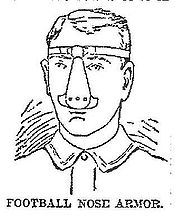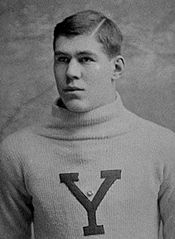
1890 College Football All-America Team
Encyclopedia
.jpg)
College Football All-America Team
The College Football All-America Team is an honor given annually to the best American college football players at their respective positions. The original usage of the term All-America seems to have been to the 1889 College Football All-America Team selected by Casper Whitney and published in This...
. The team was selected by Casper Whitney and published in This Week's Sports.
Overview
All eleven members of the 1890 All-America team played for three teams -- Harvard, Princeton or Yale, then known as the "Big Three" of college football. Some sources indicate that Walter CampWalter Camp
Walter Chauncey Camp was an American football player, coach, and sports writer known as the "Father of American Football". With John Heisman, Amos Alonzo Stagg, Pop Warner, Fielding H. Yost, and George Halas, Camp was one of the most accomplished persons in the early history of American football...
assisted Whitney with the selection of the 1890 All-American team, while others indicate that Camp did not become involved in the selection process until some time in the early 1890s.



College Football Hall of Fame
The College Football Hall of Fame is a hall of fame and museum devoted to college football. Located in South Bend, Indiana, it is connected to a convention center and situated in the city's renovated downtown district, two miles south of the University of Notre Dame campus. It is slated to move...
: Harvard's great tackle Marshall "Ma" Newell
Marshall Newell
Marshall "Ma" Newell was an American football player. He was elected to the College Football Hall of Fame in 1957.-Early years:...
, Yale's guard William "Pudge" Heffelfinger
William Heffelfinger
-External links:...
, and Yale's halfback Thomas "Bum" McClung.
The strength of the 1890 team is demonstrated by the fact that a majority of the players selected (seven of eleven) were selected as All-Americans in multiple years. They are: Pudge Heffelfinger (1889, 1890 and 1891), John Corbett (1889 and 1890), Marshall Newell (1890 and 1891), Frank Hallowell
Frank Hallowell
Frank W. Hallowell was an All-American football player. He played at the end position for Harvard University and was twice selected as an All-American, in 1890 and 1892. He was also a center fielder on Harvard's baseball team....
(1890 and 1892), Jesse Riggs
Jesse Riggs
Jesse Bright Riggs was an All-American football player. Riggs played for the Princeton University football team from 1888 to 1891. He was an All-American in 1890 and captain of the 1891 Princeton football team....
(1890 and 1891), "Bum" McClung (1890 and 1891), and Sheppard Homans (1890 and 1891).
The team included men who went on to great success in their careers. McClung went on to become the Treasurer of the United States
Treasurer of the United States
The Treasurer of the United States is an official in the United States Department of the Treasury that was originally charged with the receipt and custody of government funds, though many of these functions have been taken over by different bureaus of the Department of the Treasury...
under U.S. President William Howard Taft
William Howard Taft
William Howard Taft was the 27th President of the United States and later the tenth Chief Justice of the United States...
, and his signature appears on U.S. currency issued during the years 1909-1912. Heffelfinger became the first "professional" football player in 1892 when he was paid $25 for his expenses and a bonus of $500 by the Allegheny Athletic Association
Allegheny Athletic Association
The Allegheny Athletic Association was an athletic club that fielded the first ever professional American football player and later the first fully professional football team. The organization was founded in 1890 as a regional athletic club in Allegheny, Pennsylvania, which is today the North...
to play in a game against the rival Pittsburgh Athletic Club. Harvard's quarterback Dudley Dean
Dudley Dean
Dudley S. Dean was an All-American football quarterback for Harvard University. He played quarterback for Harvard from 1888-1890 and was selected as an All-American in 1890...
enlisted in Teddy Roosevelt
Theodore Roosevelt
Theodore "Teddy" Roosevelt was the 26th President of the United States . He is noted for his exuberant personality, range of interests and achievements, and his leadership of the Progressive Movement, as well as his "cowboy" persona and robust masculinity...
's Rough Riders
Rough Riders
The Rough Riders is the name bestowed on the 1st United States Volunteer Cavalry, one of three such regiments raised in 1898 for the Spanish-American War and the only one of the three to see action. The United States Army was weakened and left with little manpower after the American Civil War...
and was decorated for his role in the Battle of San Juan Hill.
The team also included players who met with tragic endings. Newell was killed on Christmas Eve 1897 when a railroad engine accidentally backed up over him. Princeton's end Ralph Warren suffered a severely twisted neck in the 1891 Princeton-Yale game and wandered off several weeks later, having reportedly suffered a mental breakdown as a combined result of the injury and despondency over the loss to Yale.
Football in 1890 was a brutal sport, played before the introduction of helmets and other protective gear. Serious injuries and even deaths were common occurrences in the game. Harvard's All-American center, John Cranston
John Cranston (American football)
John S. Cranston was an American football player and coach. He played for Harvard University from 1888-1890. He was selected as an All-American in 1889 and 1890—the first years in which College Football All-America Teams were selected...
, was the first player to wear equipment to protect his face during an American football
American football
American football is a sport played between two teams of eleven with the objective of scoring points by advancing the ball into the opposing team's end zone. Known in the United States simply as football, it may also be referred to informally as gridiron football. The ball can be advanced by...
game. In order to protect Cranston's "weak nose," Harvard captain and 1889 All-American
1889 College Football All-America Team
The 1889 College Football All-America team was the first College Football All-America Team. The team was selected by Casper Whitney and published in This Week's Sports....
Arthur Cumnock
Arthur Cumnock
Arthur James Cumnock was an American football player. He and Amos Alonzo Stagg were selected as the ends on the first College Football All-America Team in 1889. He is also credited with having been the person who developed the tradition of spring practice in football...
invented a device that he called "nose armor." Cumnock's invention gained popularity, and in 1892, a newspaper article described the growing popularity of the device:
"By the invention of nose armor football players who have been hitherto barred from the field because of broken or weak noses are now able to thrust an armor protected nose (even though it be broken) into the center of the roughest scrimmage without danger to the sensitive nasal organ. The armor is made of fine rubbber and protects both the nose and teeth."
In 1952, Grantland Rice
Grantland Rice
Grantland Rice was an early 20th century American sportswriter known for his elegant prose. His writing was published in newspapers around the country and broadcast on the radio.-Biography:...
paid tribute to Princeton's fullback Sheppard Homans as the embodiment of the rough and tumble days of iron man football. Rice wrote: "Just as Ty Cobb
Ty Cobb
Tyrus Raymond "Ty" Cobb , nicknamed "The Georgia Peach," was an American Major League Baseball outfielder. He was born in Narrows, Georgia...
represents the ball game of many years ago, this man represented the football that used to be."
Ends
- Frank HallowellFrank HallowellFrank W. Hallowell was an All-American football player. He played at the end position for Harvard University and was twice selected as an All-American, in 1890 and 1892. He was also a center fielder on Harvard's baseball team....
, Harvard - Ralph Warren, Princeton
Tackles

- Marshall NewellMarshall NewellMarshall "Ma" Newell was an American football player. He was elected to the College Football Hall of Fame in 1957.-Early years:...
, Harvard (College Football Hall of Fame) - William RhodesWilliam Rhodes (American football)William Castle "Billy" Rhodes was American football player and coach. Rhodes played tackle at Yale University from 1887 to 1890 and was selected for the 1890 College Football All-America Team...
, Yale
Guards
- Pudge Heffelfinger, Yale (College Football Hall of Fame)
- Jesse RiggsJesse RiggsJesse Bright Riggs was an All-American football player. Riggs played for the Princeton University football team from 1888 to 1891. He was an All-American in 1890 and captain of the 1891 Princeton football team....
, Princeton
Halfbacks
- Thomas McClung, Yale (College Football Hall of Fame)
- John CorbettJohn Corbett (American football)John J. Corbett was an American football player and coach of multiple sports in the United States. He played football for Harvard University from 1890 to 1893 and was selected as one of the two halfbacks on the 1890 College Football All-America Team...
, Harvard

